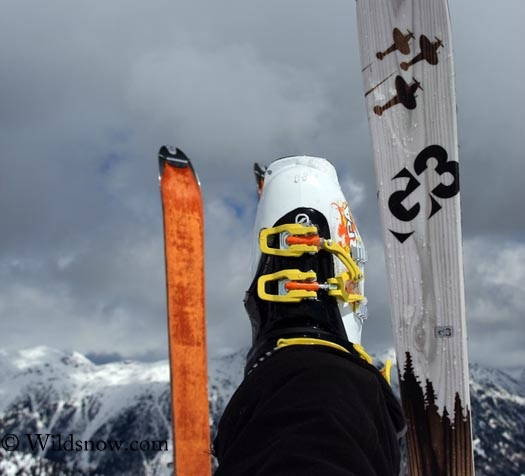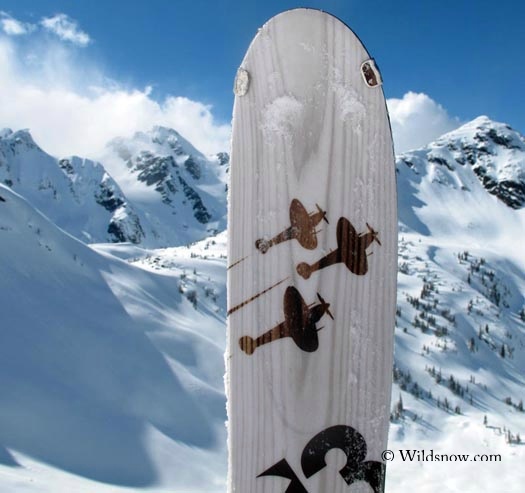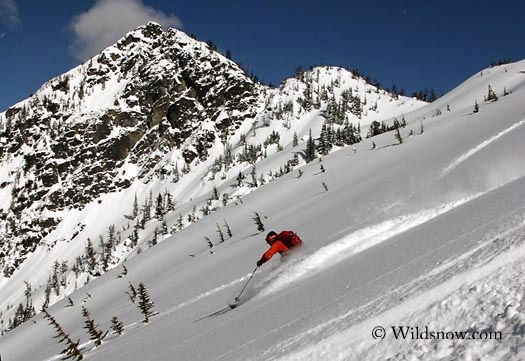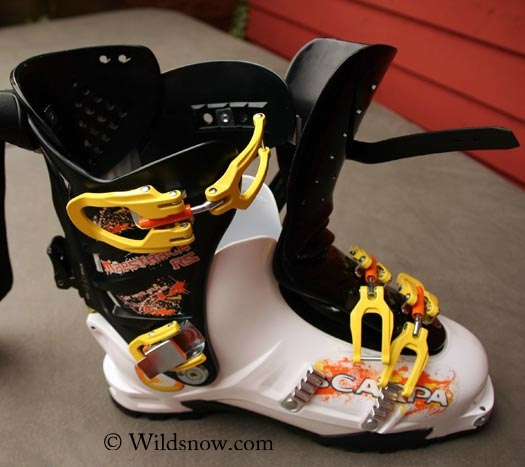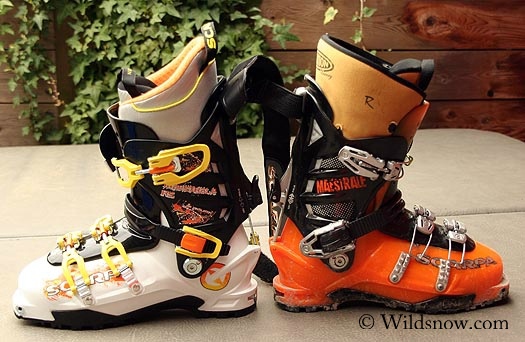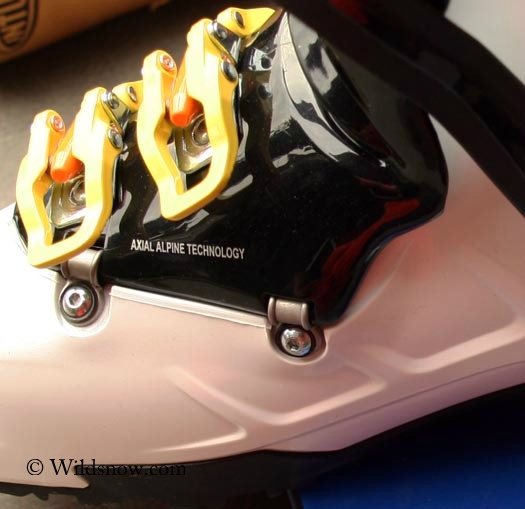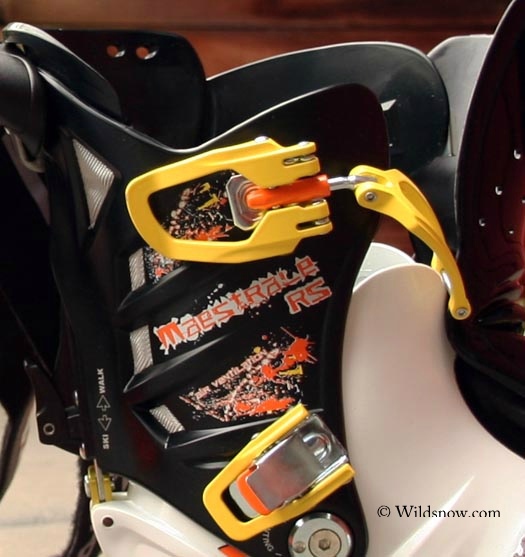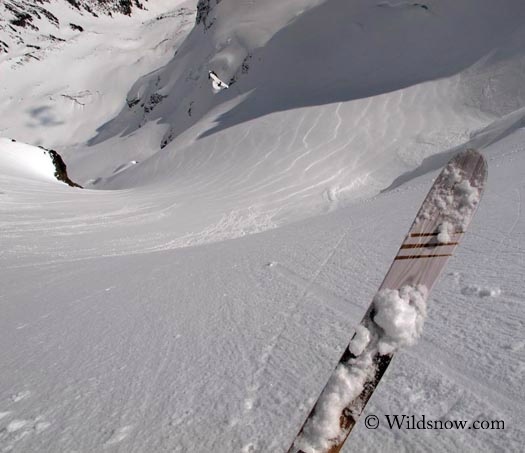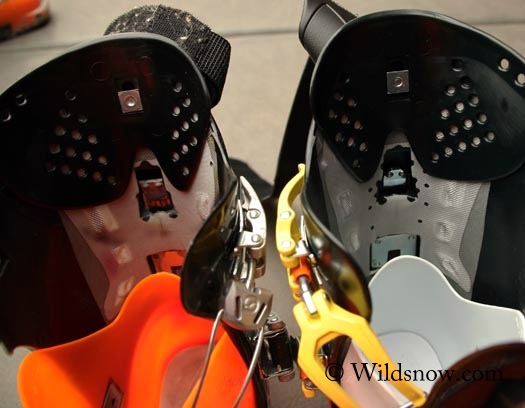While this is primarily a review of Scarpa’s new 2012/13 version Maestrale RS backcountry skiing boot, I paired the shoes with new planks from G3. So this also became a review of next season’s G3 Spitfire LT skis. I was on production versions of these products made available for testing and review. (Photos and video by Lee Lau unless otherwise noted.)
Maestrale RS has already been previewed on Wildsnow here. The Maestrale RS is derived from Scarpa’s Maestrale alpine touring boot. Original Maestrale was wildly popular both for its Halloween pumpkin good looks (ha), performance, and for reasonable pricing (almost heretical in this very costly industry). This is Scarpa’s best-selling ever alpine touring boot. You can review Wildsnow’s review of Maestrale here as well as the long term review. To summarize my experience, you can think of the Maestrale RS as a stiffer, uglier version of the Maestrale with mounting hardware that isn’t problematic.
G3’s Spitfire LT adds an early rise tip to the older 2011 variant that ironically states in its G3 description that “you don’t mess with success”. I for one am glad G3 did mess with success. The new early rise tip made all the difference in the world for me in the characteristic variability of spring Coast Mountains skiing (powder interspersed with crust, glace, ice, and bushwhack). Yes, Spitfire LT is everything I look for in a spring ski – light, exceptionally quick and superior edge hold.
G3 Spitfire LT Skis – specifics
G3 Spitfire LT is a touring-specific ski with 120/88/111 dimensions (tip, waist, tail in millimeters) and a turning radius of 20m in the 177cms length tested. The Spitfire’s claimed weight is 1360g per ski; 1372g per ski (actual). Spitifre LT is made with G3’s “core light tech,” meaning a carefully constructed core using woods such as paulowania and poplar, combined with multi-axial fiberglass wrap.
Scarpa Maestrale RS Boots
I’m not a fashion queen (which means obviously that I am a fashion queen) but can’t help feeling that someone sprayed Neapolitan ice-cream all over these boots! Thankfully that’s about the only major thing I can think of that I do not like about the Maestrale RS. From the preview article and my observations I provide the following nuggets:
– Four-buckle construction with the same by now familiar heel holding middle strap located in the sweet spot we wish some other boot makers were aware of.
– Maestrale RS has two ski modes; 16 and 20 degrees so its slightly more upright than before (hmmm, a trend?). With 40 degree cuff movement that wonderful walk mode is preserved.
– Fasteners use rivets now instead of removable hardware as first model had. Usually I’d say that’s a step backwards because many of us like to fuss with our boots, but given that last year’s hardware was problematic for Scarpa, overall a good thing.
– Shell is now made from grilamid/polyamide; a plastic that can be molded thinner and lighter than Pebax with same stiffness but adds cost to the boot (hence the price increase of around $100).
– Tongue remains Pebax but is noticeably stiffer than the tongue from the old Maestrale. I took the tongues off the Maestrale RS to compare with Maestrale and they’re interchangeable.
– Buckles are beefier which I am told by Scarpa contributes to boot stiffness. How that would be is mystifying. Isn’t a buckle just a buckle? Or perhaps buckles stretch? The huge buckles definitely detract from the elegance of the old boot and probably add a bit of weight — we suspect they’re mostly for shelf appeal. But beef can be good so we’ll let that one rest.
– Tongue hinges stronger than the ones on the first retail models of the Maestrale, but we feel they could be stronger. I’m not crazy about those little hinges as I’ve found them fragile and have broken them (replacement hinges are easily available from Scarpa). Interesting they’d make the buckles huge but not do much with beefing the tongue hinges. Mysteries of the boot market.
– Sizes are 24.5-32 for Maestrale RS, 22.5-27 for Gea RS (women’s version)
As to how reliable the hardware fastening is on this boot, I checked all the threaded fasteners (fewer now, as mentioned above) before field testing and the hardware was tight. After the 10 days I went over them again and all was still locked down nicely. I then proceeded to disassemble the hardware (continuing the fine Wildsnow tradition of messing with perfectly good equipment) and found the fasteners to have liberal amounts of red Loctite. Hooray!
I’ll end with observations for you weight weenies. The OE Scarpa Maestrale RS liner (custom made for them by Intuition) is 263g and is supposed to be beefier to match the beef of the boot. The Intuition luxury liners I’m going to stick in the Maestrale RS for testing are 220g. The shell weight of Maestrale RS is 1316g while the shell weight of Maestrale is 1305g, a minimal difference but nonetheless LESS instead of more. Maestrale RS is supposed to be 1559g (or 3lbs 15oz as stated in the PR in Americanese). My test pair of Maestrale RS measured 1579g but with my own Intution liners they come in at 1536g.
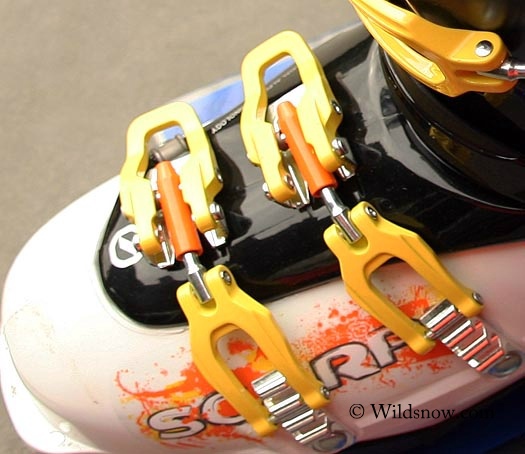
Buckles are beefier; purportedly stiffer but not as elegant as the old wire buckles. I leave the lowest buckle almost completely loose and yes, could take it off completely as some guy named Lou tends to do to nearly all his 4-buckle boots.
G3 Spitfire LT Ski
My old spring ski (Atomic Tm:ex with Dynafit Comforts) is what can be politely called a “classic” setup. Relatively narrow (84mm underfoot), stiff throughout, now losing its camber, and with so little base material left that it cannot even be ground. I’ve been waiting for something exceptional to take its place. The G3 Spitfire LT appears to be that ski. Ever so slightly fatter but fatness is not what I look for in a spring setup.
Spring skiing requires a peculiar animal. Big long lines will hopefully go down with snow that will change dramatically with the elevation. There will be long slogs to skiable terrain with long approaches so the ski should be decently light. Terrain will be tight (either by way of couloir entries or tree exits) so the skis should be on the shorter side. Snow might be “firm” (codeword for impenetrable) and “sporty” (codeword for breakable crust) so the skis must have edgehold yet be versatile.
The old soldier TM:ex’s were not versatile with the stiff tips making them a tip-dive machine. While their old-school shape and stiffness definitely kept you honest I’ve become a big fan or “early rise” tips. Best described through a picture (see below), the Spitfire LT still has traditional camber but the tips splay a bit. G3 implements “early rise” differently throughout its ski lineup with the Spitfire LT having the least amount of rise, the Tonic/Zenoxide having a bit more rise and the fattest skis having the most rise to the point of almost being rockered. The effect of early rise is most readily apparent in crusty snow where no doubt I’d have been head-planting a few times on my old rig but which was handled with aplomb with the Spitfire LTs.
The light weight of the Spitfire LTs is appreciated on the uphill either on your feet or on your pack. Square ever-so-slightly upturned tails with a little notch cut for skins is always appreciated for touring-friendliness. On groomers they carve reasonably well only blowing out tails if you lean them racer style into corduroy at mach-looney speeds. They’re as quick as the dimensions suggest in tight turns and if your style is to bum wiggle wedel turns you’ll be pretty happy with these skis. Their limit is found for straightlining open faces; obviously they’re smaller skis and accordingly not the tool of choice for outrunning sluff on deep powder spine lines.
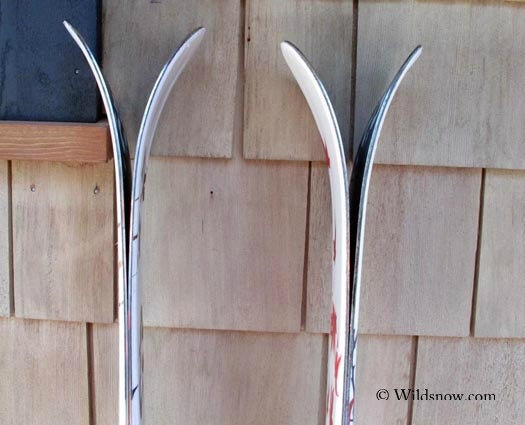
Spitfire LT (left) has a slight early rise tip compared with a G3 Tonic (right) which has more of an early rise tip
Scarpa Maestrale RS Fit and Impressions
Fit
I have a traditional Asian foot; which means that my forefoot is wider then what most ski boots are designed for and I have no arch to speak of. The Maestrale RS has the same last as the Maestrale so if you fit one you’ll fit the other (note that the Skookum, Mobe, Spirit 3 and 4 have a different last and were higher volume so do not extrapolate fit from those boots). Once I cooked the Intuition-made liner I could tour and ski the Maestrale RS without discomfort. In the size 27.5 tested, boot sole length was 306mm. The heel pocket isn’t tight so if you’re used to a performance alpine boot, there is not much anatomical shaping going on. If you have heel lift I’d recommend some padding and the services of a bootfitter.
According to Scarpa’s literature the stock RS liners are “beefier” version of Intuition Pro-tours hence their additional weight. The added heft appears to be in slightly thicker padding at the ankle bone and the forefoot.
Performance- up hill and touring
I’ve already bleated enough about touring in the Maestrale and Rush boots that I can fairly be accused of being a Scarpa fanboy. The Maestrale RS is no different, and frankly, It’s nirvana to skin uphill in a boot with so much range of motion (40 degrees of cuff range – going from + 20 to -20). So much cuff range and the relative light weight makes this a dream for self-powered endeavors. Note that the Maestrale RS (as with Rush and Maestrale) tours much better when you slack off all buckles and the power strap. This does mean slower transitions as you will have to go through the extra step of re-tightening buckles and the power strap as you prepare to go downhill.
Performance – downhill
No question the Maestrale RS is stiffer than the Maestrale. As mentioned earlier I took the tongues off both boots and compared. The Maestrale RS’s tongue had the same construction with a slight bellows in the middle (conducive to touring) but was was noticeably stiffer in flex. If anyone remembers from “back-in-the-day” when the Megaride was the de rigeur boot of choice and people were stiffening them up with Raichle Flexon tongues, the Maestrale tongue can be equated to the stock Megaride tongue while the Maestrale RS tongue can be equated to the Flexon purple tongue which was just shy of stiffness of the downhillers orange tongue. The Maestrale RS boot lowers also appear stiffer thus bearing out Scarpa’s assertion that the polyamide/grilamid Maestrale RS plastic is stiffer than the Pebax used in Maestrale.
How much stiffer? Suffice it to say that when I skied the Maestrale my advice was to crank the buckles and powerstrap tight to get the boot to become stiff. With the Maestrale RS I do not crank the buckles as tight and don’t even bother doing up the powerstrap. I don’t even bother tightening the lower buckle and could easily just remove that buckle without missing it. To compare against other boots in Scarpa’s lineup I’d have to say that Maestrale RS is stiffer than the Skookum boot. If I wasn’t so in love with this boot so much that self-doubt about my own objectivity is creeping in, I’d even go so far as to say that it’s comparable to the Scarpa Mobe (the boot I previously thought was Scarpa’s stiffest) at least in lateral stiffness if not in fore-aft stiffness.
This leads to an interesting quandary for Scarpa. The Maestrale was so good that it basically killed off the Spirit 3 and 4 line. The Maestrale RS takes it one step further and basically skis better or at least as well as the Mobe and Skookum while being a significantly better touring boot. It’ll be interesting to see how Scarpa can top this boot which, at this price point and performance level, we at WildSnow.com predict will be a worldwide favorite.
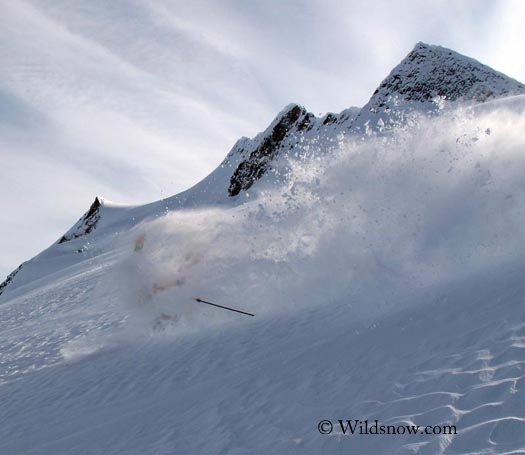
I wish I had the Maestrale and Spitfire on these trips I took to the Selkirks earlier in the year. I'll be long-term testing the Maestrale RS throughout next season and perhaps that'll be one of the places where the new gear will shine.
Shop for Scarpa alpine touring ski boots here.
Lee’s personal biases and test conditions: I weigh 165 lbs and ski mainly in the Coast Mountains of British Columbia in the Vancouver/Whistler area. My skiing is usually in fairly high moisture-content snow and I am not a finesse skier. Accordingly, my preference is for bigger skis and boots. I ski about a 100 days a season, 70% of which days involves some backcountry skiing. I’ve spent 10 days on the Maestrale RS boots and on the Spitfire LT skis with 2 inbound days and the rest touring in powder and then in spring touring conditions. My personal skis are G3 Zenoxides, BD Zealots and Atomic TM:ex. My personal boots are the Scarpa Maestrale and the Dynafit ZZeus.
(Guest blogger Lee Lau is an avid skier and outdoorsman embarking on many adventures with his loving, and sometimes concerned wife, Sharon. He has over fifteen years of experience backcountry skiing and dabbles in mountaineering. In the “off-season” he is occasionally found working in his day job as an intellectual property lawyer when he is not mountain biking. As a resident of Vancouver and Whistler, British Columbia, Lee’s playground extends mainly to Western Canada, including South West B.C. and the Selkirks. Lee and Sharon share experiences at www.sharonandlee.net)
Guest blogger Lee Lau is an avid skier and outdoorsman embarking on many adventures with his loving, and sometimes concerned wife, Sharon. He has over 15 years of experience skiing, ski-touring and dabbles in mountaineering. In the “off-season” he is occasionally found working in his day job as an intellectual property lawyer when he is not mountain biking. As a resident of Vancouver, British Columbia, Lee’s playground extends mainly to Western Canada, including South West B.C. and the Selkirks.

